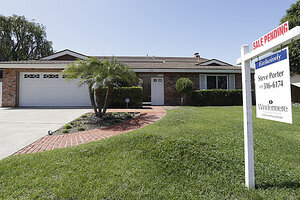Existing home sales surge 6.5 percent in July. That's huge, but can it last?
Existing home sales leaped 6.5 percent in July, their highest level since last 2009 when a tax credit artificially boosted sales. But some analysts worry that rising interest rates and continuing low inventory could put a damper on existing home sales in the coming months.

A home is offered for sale in San Diego. The National Association of Realtors said Wednesday, Aug. 21, 2013, that existing home sales jumped 6.5 percent last month from a 5.06 million pace in June. They have risen 17.2 percent over the past 12 months.
Gregory Bull/AP/File
The housing recovery continues to speed along, and last month, a key indicator came up big. But can it last?
Existing home sales surged 6.5 percent to a 5.39 million annualized rate in July compared with June, according to the latest data released by the National Association of Realtors (NAR). That’s the highest level since November 2009, when a home buyer’s tax credit was first introduced to boost sales. Last month's gains were felt in all four regions. Single-family home sales jumped 6.2 percent. The multifamily home category, which is traditionally more volatile and includes co-ops and condominiums, increased by 8.6 percent. Total existing home sales are up 17.2 percent since a year ago.
The possible reason? The inventory squeeze that real estate agents have been pointing to as hampering the sales pace in some regions may be starting to ease up.
“We viewed lean inventories as the main factor slowing the pace of sales in recent months,” Michael Gapen, an analyst at Barclays Research, wrote via e-mailed analysis. “Inventories of existing homes were below 2 [months’ supply] for five consecutive months between November and March, a streak not seen in the US in more than a decade. In recent months, however, inventory levels have begun to normalize as new supply has come onto the market, although the level of inventories still remains lean by historical standards. We continue to expect that existing home sales will gradually improve as labor markets heal and housing demand firms.”
The months’ supply of homes stayed at 5.1 months in July, and the median amount of time a home sat on the market was 42 days – up from 37 days in June.
There were more hopeful signs in the makeup of the July sales figures. The proportion of foreclosures is decreasing, making up 15 percent of home sales in July. And the role of investors (as opposed to buyers looking for homes to live in) is diminishing. Investment sales made up 16 percent of sales in July, a drop from a 17 percent share in June and a 22 percent share in February. “Demand for homes to live in was even stronger than the headline number suggests since investors played a smaller role than they have in the past,” IHS Global Insight economist Patrick Newport wrote in an e-mail analysis.
But despite July’s robust numbers, there are a few things that concern analysts going forward. Mortgage applications have been falling sharply since June, which could portend a drop-off in sales next month. Some analysts, including economist Lawrence Yun at the NAR, argue that rising interest rates and accelerating prices could "diminish the pool of eligible buyers.” And it’s still unclear how much a rapid rise in interest rates (which are still low by historical standards) would affect the market.
However, the bottom line is still cautiously optimistic. “The housing market remains in a recovery phase, albeit one that could be tempered by higher mortgage rates and worsening affordability,” Mr. Gapen wrote. “Low inventories had been cutting two ways, supporting home price appreciation and home building, but reducing the pace of existing home sales. We believe the recovery in housing will prove resilient to any broader slowing in the economy and the recent rise in mortgage interest rates to date, but we will be watching for any signs of weakness or fragility as a result of the significant rise in real interest rates over the past several months."

